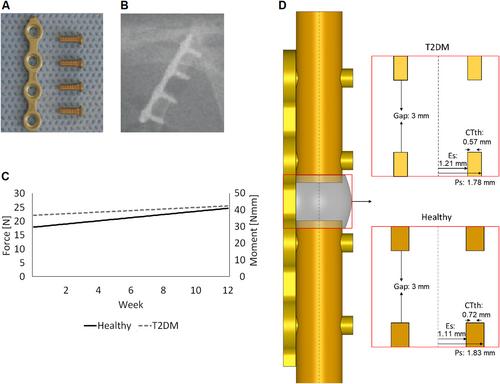{"title":"Reduced Bone Regeneration in Rats With Type 2 Diabetes Mellitus as a Result of Impaired Stromal Cell and Osteoblast Function—A Computer Modeling Study","authors":"Mahdi Jaber, Lorenz C Hofbauer, Christine Hofbauer, Georg N Duda, Sara Checa","doi":"10.1002/jbm4.10809","DOIUrl":null,"url":null,"abstract":"<p>Bone has the fascinating ability to self-regenerate. However, under certain conditions, such as type 2 diabetes mellitus (T2DM), this ability is impaired. T2DM is a chronic metabolic disease known by the presence of elevated blood glucose levels that is associated with reduced bone regeneration capability, high fracture risk, and eventual non-union risk after a fracture. Several mechanical and biological factors relevant to bone regeneration have been shown to be affected in a diabetic environment. However, whether impaired bone regeneration in T2DM can be explained due to mechanical or biological alterations remains unknown. To elucidate the relevance of either one, the aim of this study was to investigate the relative contribution of T2DM-related alterations on either cellular activity or mechanical stimuli driving bone regeneration. A previously validated in silico computer modeling approach that was capable of explaining bone regeneration in uneventful conditions of healing was further developed to investigate bone regeneration in T2DM. Aspects analyzed included the presence of mesenchymal stromal cells (MSCs), cellular migration, proliferation, differentiation, apoptosis, and cellular mechanosensitivity. To further verify the computer model findings against in vivo data, an experimental setup was replicated, in which regeneration was compared in healthy and diabetic after a rat femur bone osteotomy stabilized with plate fixation. We found that mechanical alterations had little effect on the reduced bone regeneration in T2DM and that alterations in MSC proliferation, MSC migration, and osteoblast differentiation had the highest effect. In silico predictions of regenerated bone in T2DM matched qualitatively and quantitatively those from ex vivo μCT at 12 weeks post-surgery when reduced cellular activities reported in previous in vitro and in vivo studies were included in the model. The presented findings here could have clinical implications in the treatment of bone fractures in patients with T2DM. © 2023 The Authors. <i>JBMR Plus</i> published by Wiley Periodicals LLC on behalf of American Society for Bone and Mineral Research.</p>","PeriodicalId":14611,"journal":{"name":"JBMR Plus","volume":"7 11","pages":""},"PeriodicalIF":3.4000,"publicationDate":"2023-10-02","publicationTypes":"Journal Article","fieldsOfStudy":null,"isOpenAccess":false,"openAccessPdf":"https://asbmr.onlinelibrary.wiley.com/doi/epdf/10.1002/jbm4.10809","citationCount":"0","resultStr":null,"platform":"Semanticscholar","paperid":null,"PeriodicalName":"JBMR Plus","FirstCategoryId":"1085","ListUrlMain":"https://onlinelibrary.wiley.com/doi/10.1002/jbm4.10809","RegionNum":0,"RegionCategory":null,"ArticlePicture":[],"TitleCN":null,"AbstractTextCN":null,"PMCID":null,"EPubDate":"","PubModel":"","JCR":"Q2","JCRName":"ENDOCRINOLOGY & METABOLISM","Score":null,"Total":0}
引用次数: 0
Abstract
Bone has the fascinating ability to self-regenerate. However, under certain conditions, such as type 2 diabetes mellitus (T2DM), this ability is impaired. T2DM is a chronic metabolic disease known by the presence of elevated blood glucose levels that is associated with reduced bone regeneration capability, high fracture risk, and eventual non-union risk after a fracture. Several mechanical and biological factors relevant to bone regeneration have been shown to be affected in a diabetic environment. However, whether impaired bone regeneration in T2DM can be explained due to mechanical or biological alterations remains unknown. To elucidate the relevance of either one, the aim of this study was to investigate the relative contribution of T2DM-related alterations on either cellular activity or mechanical stimuli driving bone regeneration. A previously validated in silico computer modeling approach that was capable of explaining bone regeneration in uneventful conditions of healing was further developed to investigate bone regeneration in T2DM. Aspects analyzed included the presence of mesenchymal stromal cells (MSCs), cellular migration, proliferation, differentiation, apoptosis, and cellular mechanosensitivity. To further verify the computer model findings against in vivo data, an experimental setup was replicated, in which regeneration was compared in healthy and diabetic after a rat femur bone osteotomy stabilized with plate fixation. We found that mechanical alterations had little effect on the reduced bone regeneration in T2DM and that alterations in MSC proliferation, MSC migration, and osteoblast differentiation had the highest effect. In silico predictions of regenerated bone in T2DM matched qualitatively and quantitatively those from ex vivo μCT at 12 weeks post-surgery when reduced cellular activities reported in previous in vitro and in vivo studies were included in the model. The presented findings here could have clinical implications in the treatment of bone fractures in patients with T2DM. © 2023 The Authors. JBMR Plus published by Wiley Periodicals LLC on behalf of American Society for Bone and Mineral Research.

基质细胞和成骨细胞功能受损导致2型糖尿病大鼠骨再生减少——计算机模型研究
骨头具有自我再生的神奇能力。然而,在某些情况下,如2型糖尿病(T2DM),这种能力受损。T2DM是一种慢性代谢性疾病,血糖水平升高与骨再生能力降低、骨折风险高以及骨折后最终不愈合风险相关。一些与骨再生相关的机械和生物因素已被证明在糖尿病环境中受到影响。然而,T2DM患者骨再生受损是否可以由机械或生物学改变来解释仍不清楚。为了阐明两者之间的相关性,本研究的目的是研究t2dm相关改变对驱动骨再生的细胞活性或机械刺激的相对贡献。一种先前经过验证的计算机模拟方法能够解释在平稳愈合条件下的骨再生,该方法进一步发展用于研究T2DM的骨再生。分析的方面包括间充质间质细胞(MSCs)的存在、细胞迁移、增殖、分化、凋亡和细胞机械敏感性。为了进一步验证计算机模型的结果与体内数据的对比,我们复制了一个实验装置,比较了健康大鼠股骨截骨和钢板固定稳定后的再生情况。我们发现,机械改变对T2DM患者骨再生减少的影响很小,而MSC增殖、MSC迁移和成骨细胞分化的改变影响最大。2型糖尿病患者再生骨的计算机预测在定性和定量上与手术后12周的离体μCT结果相匹配,模型中包括了先前体外和体内研究中报告的细胞活性降低。本研究结果可能对治疗2型糖尿病患者骨折具有临床意义。©2023作者。JBMR Plus由Wiley期刊有限责任公司代表美国骨骼和矿物研究协会出版。
本文章由计算机程序翻译,如有差异,请以英文原文为准。


 求助内容:
求助内容: 应助结果提醒方式:
应助结果提醒方式:


